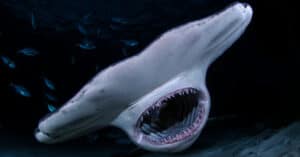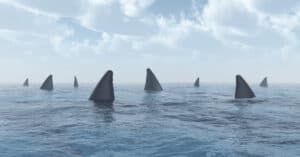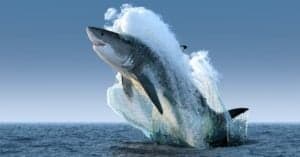What Do Nurse Sharks Eat? Their Diets Explained
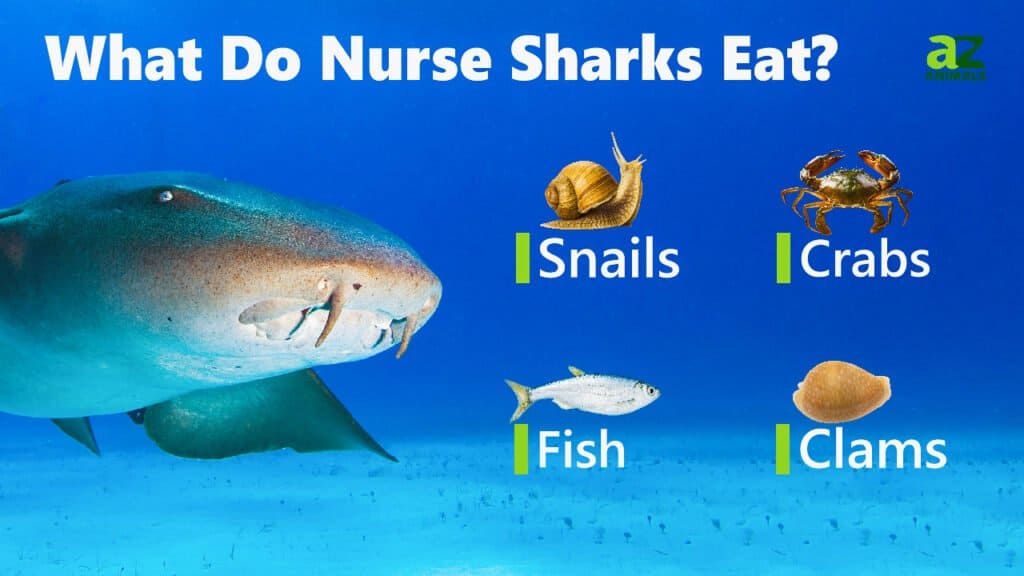
A-Z-Animals.com
Nurse sharks look a lot like the sharks you are familiar with, but you won’t see their fin ominously cutting through the surface of the ocean. They prefer to scour the bottom of the ocean searching for food and hiding in coral reefs. A unique facial feature is what looks like fangs hanging down on either side of their snout, but in reality these harmless features are nasal barbels used to sense, or taste, items on the ocean floor. Can you imagine swimming with your tongue out along the sandy bottom of the ocean? Kind of like that! Let’s explore what nurse sharks eat!
How do nurse sharks eat?
Before we discuss what nurse sharks eat we need to learn how the nurse sharks eat, it is very unique. These sharks are kind of like vacuum cleaners, they have a powerful suction system that allows them to suck up their food. The food passes through several rows of teeth and then is fully digested in the stomach.
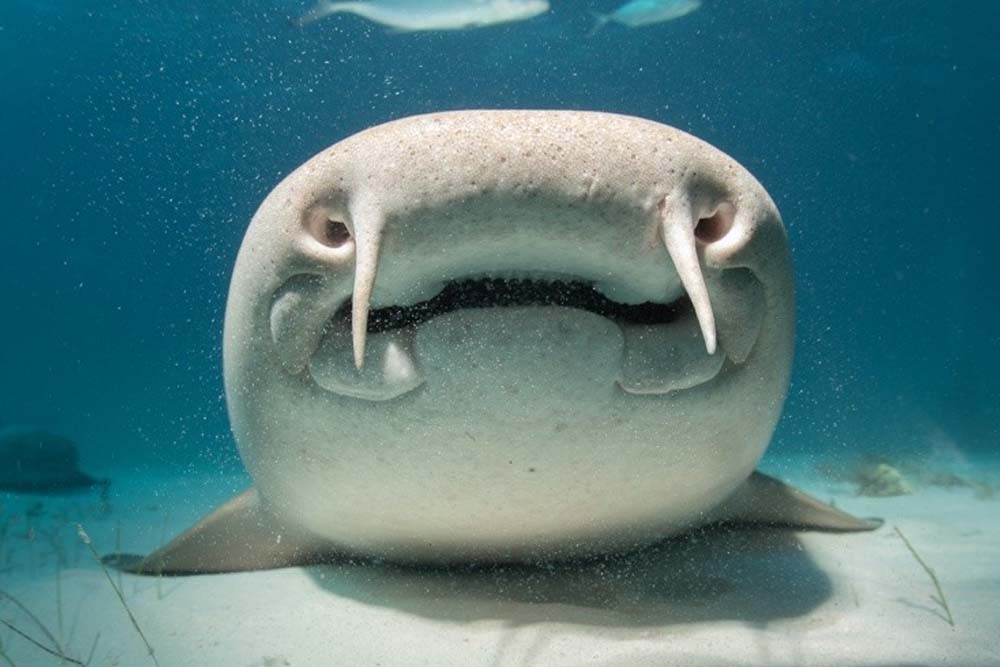
Maui Topical Images/Shutterstock.com
How do nurse sharks hunt?
Nurse sharks live in the Western Atlantic Ocean and the Eastern Pacific Ocean where they can be found near the shoreline hunting. Since they are nocturnal they often prey on small fish that are resting. They will also sometimes lay very still with their snout up to create a seemingly safe place for other sea life to hide, like crabs and clams. Then they surprise them with their powerful suction for dinner. Another hunting technique is to flip conch shells over, and with their suction and teeth, suck a snail out from its shell.
What do nurse sharks eat?
Besides snails, crabs, clams and small fish, nurse sharks also eat stingrays, squid, octopi, and sea urchins. Scientists have found algae and ground coral in their stomachs as well, but it is thought these were a part of the process of sucking up other nutritional food. Because they often hunt near the shoreline they sometimes get lucky and find a stash of fisherman’s bait (lucky for the sharks, not the fishermen!).
In short, nurse sharks are opportunistic hunters that eat meat. Their primary meals are snails, crabs, clams, and small fish.
A complete list of what nurse sharks eat:
- Crustaceans
- Mollusks
- Stingrays
- Conchs
- Squid
- Sea Urchins
- Octopi
- Clams
- Crabs
- Small Fish
- Sea Snails
- Algae
- Ground Coral
- Fisherman’s Bait!

What eats nurse sharks?
There aren’t any predators of the nurse shark. There have been occasional incidents where a larger shark, like a tiger shark, has eaten a nurse shark.
How much do nurse sharks eat?
Because nurse sharks spend most of their time slowly skimming the ocean floor or sleeping they require very little food to maintain their energy.
Who competes with nurse sharks for food?
Since there are many other fish that prefer the shallow bottom of the ocean there are competitors for the surrounding fish, squid, clams and shrimp. The Summer Flounder is one of these bottom-dwelling fish that is on the lookout for the same diet. The Bonefish can be found in the Atlantic, off the shores of Florida, in similar areas as the nurse sharks, looking for bony fish too.
Are nurse sharks dangerous to humans?

What should you do if you see a nurse shark while swimming? Probably nothing. They are known to be harmless to humans. The few incidents where humans have been bitten have been caused by humans irritating the sharks while the sharks were minding their own business. So steer clear of them and they should leave you alone too.
More from A-Z Animals

A-Z-Animals.com
Nurse sharks look a lot like the sharks you are familiar with, but you won’t see their fin ominously cutting through the surface of the ocean. They prefer to scour the bottom of the ocean searching for food and hiding in coral reefs. A unique facial feature is what looks like fangs hanging down on either side of their snout, but in reality these harmless features are nasal barbels used to sense, or taste, items on the ocean floor. Can you imagine swimming with your tongue out along the sandy bottom of the ocean? Kind of like that! Let’s explore what nurse sharks eat!
How do nurse sharks eat?
Before we discuss what nurse sharks eat we need to learn how the nurse sharks eat, it is very unique. These sharks are kind of like vacuum cleaners, they have a powerful suction system that allows them to suck up their food. The food passes through several rows of teeth and then is fully digested in the stomach.

Maui Topical Images/Shutterstock.com
How do nurse sharks hunt?
Nurse sharks live in the Western Atlantic Ocean and the Eastern Pacific Ocean where they can be found near the shoreline hunting. Since they are nocturnal they often prey on small fish that are resting. They will also sometimes lay very still with their snout up to create a seemingly safe place for other sea life to hide, like crabs and clams. Then they surprise them with their powerful suction for dinner. Another hunting technique is to flip conch shells over, and with their suction and teeth, suck a snail out from its shell.
What do nurse sharks eat?
Besides snails, crabs, clams and small fish, nurse sharks also eat stingrays, squid, octopi, and sea urchins. Scientists have found algae and ground coral in their stomachs as well, but it is thought these were a part of the process of sucking up other nutritional food. Because they often hunt near the shoreline they sometimes get lucky and find a stash of fisherman’s bait (lucky for the sharks, not the fishermen!).
In short, nurse sharks are opportunistic hunters that eat meat. Their primary meals are snails, crabs, clams, and small fish.
A complete list of what nurse sharks eat:
- Crustaceans
- Mollusks
- Stingrays
- Conchs
- Squid
- Sea Urchins
- Octopi
- Clams
- Crabs
- Small Fish
- Sea Snails
- Algae
- Ground Coral
- Fisherman’s Bait!

What eats nurse sharks?
There aren’t any predators of the nurse shark. There have been occasional incidents where a larger shark, like a tiger shark, has eaten a nurse shark.
How much do nurse sharks eat?
Because nurse sharks spend most of their time slowly skimming the ocean floor or sleeping they require very little food to maintain their energy.
Who competes with nurse sharks for food?
Since there are many other fish that prefer the shallow bottom of the ocean there are competitors for the surrounding fish, squid, clams and shrimp. The Summer Flounder is one of these bottom-dwelling fish that is on the lookout for the same diet. The Bonefish can be found in the Atlantic, off the shores of Florida, in similar areas as the nurse sharks, looking for bony fish too.
Are nurse sharks dangerous to humans?

What should you do if you see a nurse shark while swimming? Probably nothing. They are known to be harmless to humans. The few incidents where humans have been bitten have been caused by humans irritating the sharks while the sharks were minding their own business. So steer clear of them and they should leave you alone too.




